
Adobe Flash is a multimedia software platform used for production of animations, rich web applications, desktop applications, mobile apps, mobile games, and embedded web browser video players. Flash displays text, vector graphics, and raster graphics to provide animations, video games, and applications. It allows streaming of audio and video, and can capture mouse, keyboard, microphone, and camera input.
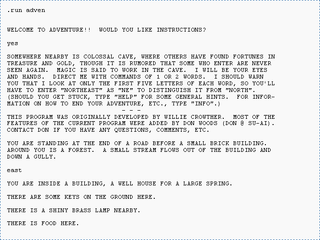
Colossal Cave Adventure is a text-based adventure game, released in 1976 by developer Will Crowther for the PDP-10 mainframe computer. It was expanded upon in 1977 by Don Woods. In the game, the player explores a cave system rumored to be filled with treasure and gold. The game is composed of dozens of locations, and the player moves between these locations and interacts with objects in them by typing one- or two-word commands which are interpreted by the game's natural language input system. The program acts as a narrator, describing the player's location and the results of the player's attempted actions. It is the first well-known example of interactive fiction, as well as the first well-known adventure game, for which it was also the namesake.

R.O.B. is a toy robot accessory for the Nintendo Entertainment System (NES). It was launched in July 1985 as the Family Computer Robot in Japan, and October 1985 as R.O.B. in North America. Its short lifespan yielded only two games in the Robot Series: Gyromite and Stack-Up.

In computing, a visual programming language or block coding is a programming language that lets users create programs by manipulating program elements graphically rather than by specifying them textually. A VPL allows programming with visual expressions, spatial arrangements of text and graphic symbols, used either as elements of syntax or secondary notation. For example, many VPLs are based on the idea of "boxes and arrows", where boxes or other screen objects are treated as entities, connected by arrows, lines or arcs which represent relations.

LeapFrog Enterprises, Inc. is an educational entertainment and electronics company based in Emeryville, California. LeapFrog designs, develops, and markets technology-based learning products and related content for the education of children from infancy through grade school. The company was founded by Michael Wood and Robert Lally in 1994. John Barbour is the chief executive officer of LeapFrog.
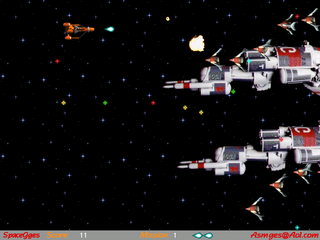
A video game genre is an informal classification of a video game based on how it is played rather than visual or narrative elements. This is independent of setting, unlike works of fiction that are expressed through other media, such as films or books. For example, a shooter game is still a shooter game, regardless of where or when it takes place. A specific game's genre is open to subjective interpretation. An individual game may belong to several genres at once.

Robot Odyssey is a programming game developed by Mike Wallace and Dr. Leslie Grimm and published by The Learning Company in December 1984. It was released for the Apple II, TRS-80 Color Computer, and MS-DOS. Most players have found it challenging. The player is readying for bed when, suddenly, they fall through the floor into an underground city of robots, Robotropolis. The player begins in the sewers of the city with three programmable robots, and must make their way to the top of the city to try to find their way home again.
A programming game is a video game that incorporates elements of computer programming, enabling the player to direct otherwise autonomous units within the game to follow commands in a domain-specific programming language, often represented as a visual language to simplify the programming metaphor. Programming games broadly fall into two areas: single-player games where the programming elements either make up part of or the whole of a puzzle game, and multiplayer games where the player's automated program is pitted against other players' programs.

Maze, also known as Maze War, is a 3D multiplayer first-person shooter maze game originally developed in 1973 and expanded in 1974. The first version was developed by high school students Steve Colley, Greg Thompson, and Howard Palmer for the Imlac PDS-1 minicomputer during a school work/study program at the NASA Ames Research Center. By the end of 1973 the game featured shooting elements and could be played on two computers connected together. After Thompson began school at the Massachusetts Institute of Technology (MIT), he brought the game to the school's computer science laboratory in February 1974, where he and Dave Lebling expanded it into an eight-player game using the school's Digital Equipment Corporation PDP-10 minicomputer and PDS-1 terminals along with adding scoring, top-down map views, and a level editor. Other programmers at MIT improved this version of the game, which was also playable between people at different universities over the nascent ARPANET. Due to the popularity of the game, laboratory managers at MIT both played it while also trying to restrict its use due to the large amount of time students were spending on it. There are reports that the Defense Advanced Research Projects Agency (DARPA) at one point banned the game from the ARPANET due to its popularity.

Flow is an independent video game created by Jenova Chen and Nicholas Clark. Originally released as a free Flash game in 2006 to accompany Chen's master's thesis, it was reworked into a 2007 PlayStation 3 game by his development studio, Thatgamecompany, with assistance from Santa Monica Studio. SuperVillain Studios developed a PlayStation Portable version of the game in 2008, and PlayStation 4 and PlayStation Vita versions in 2013. In Flow, the player navigates a series of two-dimensional (2D) planes with an aquatic microorganism that evolves by consuming other microorganisms. The game's design is based on Chen's research into dynamic difficulty adjustment at the University of Southern California's Interactive Media Division, and on psychologist Mihaly Csikszentmihalyi's theoretical concept of mental immersion or flow.
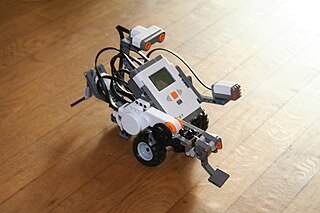
Lego Mindstorms NXT is a programmable robotics kit released by Lego on August 2, 2006. It replaced the first-generation Lego Mindstorms kit, which was called the Robotics Invention System. The base kit ships in two versions: the Retail Version and the Education Base Set. It comes with the NXT-G programming software, or optionally LabVIEW for Lego Mindstorms. A variety of unofficial languages exist, such as NXC, NBC, leJOS NXJ, and RobotC. The second generation of the set, the Lego Mindstorms NXT 2.0, was released on August 1, 2009, featuring a color sensor and other upgraded capabilities. The third generation, the EV3, was released in September 2013.
Tower defense (TD) is a subgenre of strategy games where the goal is to defend a player's territories or possessions by obstructing the enemy attackers or by stopping enemies from reaching the exits, usually achieved by placing defensive structures on or along their path of attack. This typically means building a variety of different structures that serve to automatically block, impede, attack or destroy enemies. Tower defense is seen as a subgenre of real-time strategy video games, due to its real-time origins, even though many modern tower defense games include aspects of turn-based strategy. Strategic choice and positioning of defensive elements is an essential strategy of the genre.

Greg Wohlwend is an American independent video game developer and artist whose games include Threes! and Ridiculous Fishing. He originally formed Intuition Games with Iowa State University classmate Mike Boxleiter in 2007 where they worked on Dinowaurs and other small Adobe Flash games. Trained as an artist, Wohlwend worked mainly on the visual assets. As Mikengreg, they released Solipskier, whose success let the two take a more experimental approach with Gasketball, which did not fare as well. At the same time, Wohlwend collaborated with Asher Vollmer to make Puzzlejuice, and with Adam Saltsman to make Hundreds based on Wohlwend's first game design. He later released Threes! with Vollmer in 2014 to critical acclaim. His later games TouchTone and TumbleSeed were also the products of collaborations. Wohlwend was named among Forbes' 2014 "30 under 30" in the games industry.
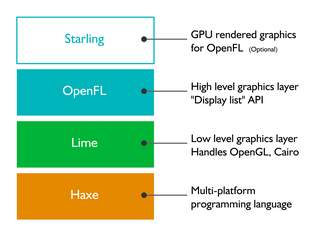
OpenFL is a free and open-source software framework and platform for the creation of multi-platform applications and video games. OpenFL applications can be written in Haxe, JavaScript, or TypeScript, and may be published as standalone applications for several targets including iOS, Android, HTML5, Windows, macOS, Linux, WebAssembly, Flash, AIR, PlayStation 4, PlayStation 3, PlayStation Vita, Xbox One, Wii U, TiVo, Raspberry Pi, and Node.js.
ASU VIPLE is a Visual IoT/Robotics Programming Language Environment developed at Arizona State University.
Osmo is a line of hands-on educational digital/physical games product by the company Tangible Play, based in Palo Alto, California. Osmo's products are built around its proprietary “Reflective Artificial Intelligence,” a system that uses a stand and a clip-on mirror to allow an iPad or iPhone's front-facing camera to recognize and track objects in the physical play space in front of the device.
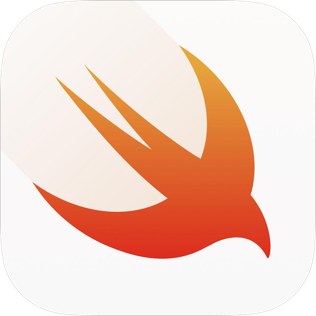
Swift Playgrounds is an educational tool and development environment for the Swift programming language developed by Apple Inc., initially announced at the WWDC 2016 conference. It was introduced as an iPad application alongside iOS 10, with a macOS version introduced in February 2020. It is available for free via Apple's App Store for iPadOS and Mac App Store for macOS.
Catrobat is a block-based visual programming language and Open Source Software non-profit project. The first release dates back to 2010 and was initiated by Wolfgang Slany from the Technical University Graz in Austria. The multidisciplinary team develops the programming language and free apps for teenagers to create their own games, animations, music videos or all other kinds of apps directly on a smartphone based on the catrobat framework.

Secret Coders is a series of graphic novels that combines logic puzzles, basic programming instruction, and a story where a group of seventh graders uncover a secret coding school. The series is written by Gene Luen Yang, illustrated by Mike Holmes, and published by First Second Books.














